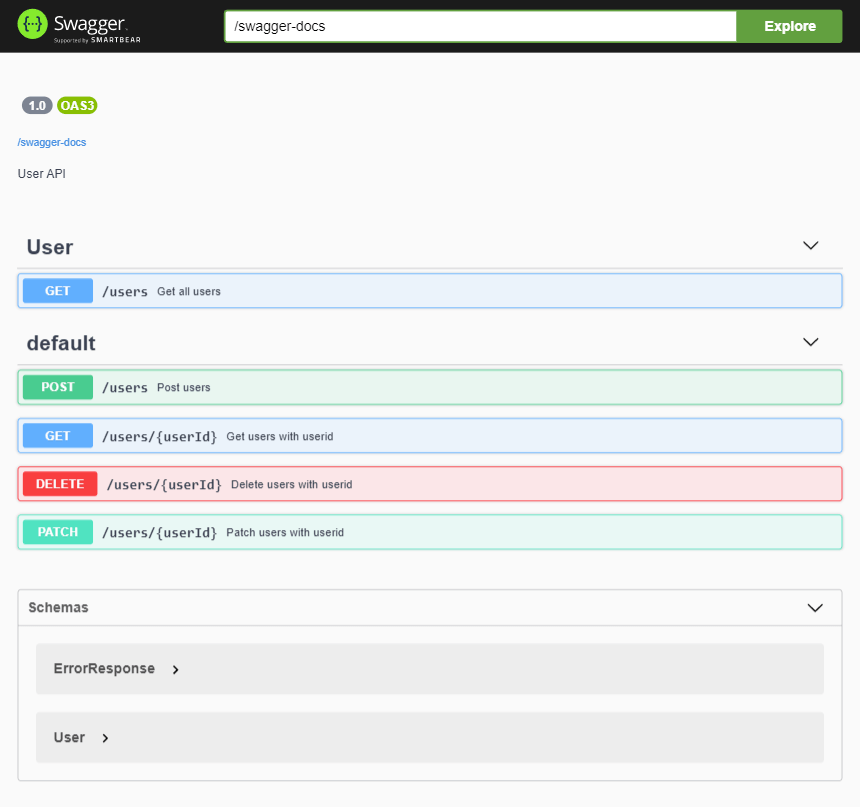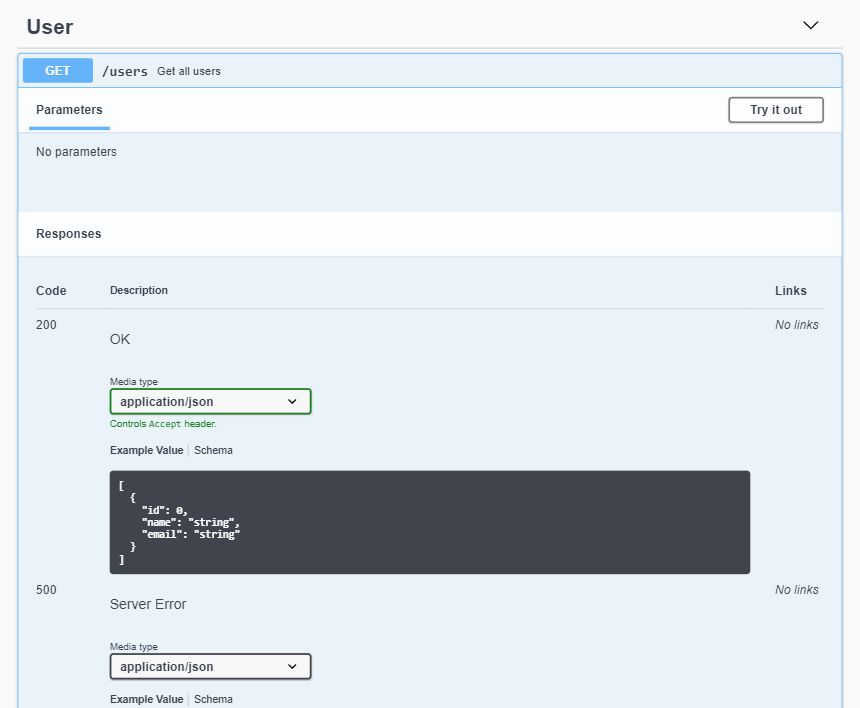What you will learn
This tutorial will teach you how to use the Javalin OpenAPI plugin to create an OpenAPI spec (previously known as a “Swagger spec”). The OpenAPI spec is an API description format for REST APIs, which is readable for both humans and machines. A spec can be used to generate web based documentation and API clients for all major languages, saving a lot of time for API consumers.
We will build a User CRUD API with five operations and generate an OpenAPI spec for it.
The example snippets contain both Java and Kotlin code,
and a project for each language is available on
GitHub.
Dependencies
First, we need to create a Maven project with our dependencies: (→ Tutorial)
<dependencies>
<dependency>
<groupId>io.javalin</groupId>
<artifactId>javalin-bundle</artifactId>
<version>6.7.0</version>
</dependency>
<dependency>
<groupId>io.javalin.community.openapi</groupId>
<artifactId>javalin-openapi-plugin</artifactId>
<version>6.7.0</version>
</dependency>
<dependency>
<groupId>io.javalin.community.openapi</groupId>
<artifactId>javalin-swagger-plugin</artifactId>
<version>6.7.0</version>
</dependency>
<dependency>
<groupId>io.javalin.community.openapi</groupId>
<artifactId>javalin-redoc-plugin</artifactId>
<version>6.7.0</version>
</dependency>
</dependencies>
The javalin-bundle dependency includes Javalin, Jackson and a logger.
We also need to add a build section for the Open API annotations:
<build>
<sourceDirectory>src/main/kotlin</sourceDirectory>
<plugins>
<plugin>
<groupId>org.apache.maven.plugins</groupId>
<artifactId>maven-compiler-plugin</artifactId>
<version>3.10.1</version>
<configuration>
<source>11</source>
<target>11</target>
<annotationProcessorPaths>
<annotationProcessorPath>
<groupId>io.javalin.community.openapi</groupId>
<artifactId>openapi-annotation-processor</artifactId>
<version>${javalin.version}</version>
</annotationProcessorPath>
</annotationProcessorPaths>
</configuration>
</plugin>
</plugins>
</build>
You can view the full POM on GitHub.
Building the API
Let’s define our Main class. This is where we will be putting our server and our OpenAPI config:
- Kotlin
- Java
package io.javalin.example.kotlin
import io.javalin.Javalin
import io.javalin.apibuilder.ApiBuilder.delete
import io.javalin.apibuilder.ApiBuilder.get
import io.javalin.apibuilder.ApiBuilder.patch
import io.javalin.apibuilder.ApiBuilder.path
import io.javalin.apibuilder.ApiBuilder.post
import io.javalin.example.kotlin.user.UserController
import io.javalin.openapi.OpenApiInfo
import io.javalin.openapi.plugin.OpenApiPlugin
import io.javalin.openapi.plugin.redoc.ReDocPlugin
import io.javalin.openapi.plugin.swagger.SwaggerPlugin
fun main() {
Javalin.create { config ->
config.registerPlugin(OpenApiPlugin { pluginConfig ->
pluginConfig.withDefinitionConfiguration { version, definition ->
definition.withOpenApiInfo { info: OpenApiInfo ->
info.title = "Javalin OpenAPI example"
}
}
})
config.registerPlugin(SwaggerPlugin())
config.registerPlugin(ReDocPlugin())
config.router.apiBuilder {
path("users") {
get(UserController::getAll);
post(UserController::create);
path("{userId}") {
get(UserController::getOne);
patch(UserController::update);
delete(UserController::delete);
}
}
}
}.start(7001)
println("Check out ReDoc docs at http://localhost:7001/redoc")
println("Check out Swagger UI docs at http://localhost:7001/swagger")
}
package io.javalin.example.java;
import io.javalin.Javalin;
import io.javalin.example.java.user.UserController;
import io.javalin.openapi.plugin.OpenApiConfiguration;
import io.javalin.openapi.plugin.OpenApiPlugin;
import io.javalin.openapi.plugin.redoc.ReDocConfiguration;
import io.javalin.openapi.plugin.redoc.ReDocPlugin;
import io.javalin.openapi.plugin.swagger.SwaggerConfiguration;
import io.javalin.openapi.plugin.swagger.SwaggerPlugin;
import static io.javalin.apibuilder.ApiBuilder.*;
public class Main {
public static void main(String[] args) {
Javalin.create(config -> {
config.registerPlugin(new OpenApiPlugin(pluginConfig -> {
pluginConfig.withDefinitionConfiguration((version, definition) -> {
definition.withOpenApiInfo(info -> info.setTitle("Javalin OpenAPI example"));
});
}));
config.registerPlugin(new SwaggerPlugin());
config.registerPlugin(new ReDocPlugin());
config.router.apiBuilder(() -> {
path("users", () -> {
get(UserController::getAll);
post(UserController::create);
path("{userId}", () -> {
get(UserController::getOne);
patch(UserController::update);
delete(UserController::delete);
});
});
});
}).start(7002);
System.out.println("Check out ReDoc docs at http://localhost:7002/redoc");
System.out.println("Check out Swagger UI docs at http://localhost:7002/swagger-ui");
}
}
We enable the OpenAPI plugin by calling config.plugins.register,
and we do all our configuration in that method. As mentioned earlier, we will register
both ReDoc and Swagger UI (to generate web UIs for our API),
but you’ll most likely only use one of these in production.
The API definition in the snippet above references something called UserController,
which doesn’t exist. Let’s create a skeleton:
- Kotlin
- Java
package io.javalin.example.kotlin.user
import io.javalin.http.Context
object UserController {
fun create(ctx: Context) {
}
fun getAll(ctx: Context) {
}
fun getOne(ctx: Context) {
}
fun update(ctx: Context) {
}
fun delete(ctx: Context) {
}
}
package io.javalin.example.java.user;
import io.javalin.http.Context;
public class UserController {
public static void create(Context ctx) {
}
public static void getAll(Context ctx) {
}
public static void getOne(Context ctx) {
}
public static void update(Context ctx) {
}
public static void delete(Context ctx) {
}
}
This defines a simple CRUD API for User objects.
Adding annotations
To improve the documentation we can add annotations to the handlers.
Let’s start with Get users:
- Kotlin
- Java
@OpenApi(
summary = "Get all users",
operationId = "getAllUsers",
tags = ["User"],
responses = [OpenApiResponse("200", [OpenApiContent(Array<User>::class)])],
path = "/users",
methods = [HttpMethod.GET]
)
fun getAll(ctx: Context) {
ctx.json(UserService.getAll())
}
@OpenApi(
summary = "Get all users",
operationId = "getAllUsers",
path = "/users",
methods = HttpMethod.GET,
tags = {"User"},
responses = {
@OpenApiResponse(status = "200", content = {@OpenApiContent(from = User[].class)})
}
)
public static void getAll(Context ctx) {
ctx.json(UserService.getAll());
}
Let’s go through the different properties:
- summary - Will be used as a title, both in web docs and in client docs
- operationId - If you generate a client from the OpenAPI spec, this will be the method name
- tags - Used to group endpoints
- responses - Describes the status codes and data models the endpoint can respond with.
This particular endpoint can only answer with an array of
Userobjects.
Let’s see what our docs look like if we start the server:

Cool! We have a User category and a Schema for User.
We can explore the Get all users endpoint further by clicking on it:

We see that it takes no parameters, and that it will respond with a 200 and an array of User objects.
If you’ve cloned the repo, you can try clicking the Try it out button now,
which will give you an array of four users.
Let’s document the Update user endpoint, which takes some input and has multiple responses:
- Kotlin
- Java
@OpenApi(
summary = "Update user by ID",
operationId = "updateUserById",
tags = ["User"],
pathParams = [OpenApiParam("userId", Int::class, "The user ID")],
requestBody = OpenApiRequestBody([OpenApiContent(NewUserRequest::class)]),
responses = [
OpenApiResponse("204"),
OpenApiResponse("400", [OpenApiContent(ErrorResponse::class)]),
OpenApiResponse("404", [OpenApiContent(ErrorResponse::class)])
],
path = "/users/{userId}",
methods = [HttpMethod.PUT]
)
@OpenApi(
summary = "Update user by ID",
operationId = "updateUserById",
path = "/users/:userId",
methods = HttpMethod.PATCH,
pathParams = {@OpenApiParam(name = "userId", type = Integer.class, description = "The user ID")},
tags = {"User"},
requestBody = @OpenApiRequestBody(content = {@OpenApiContent(from = NewUserRequest.class)}),
responses = {
@OpenApiResponse(status = "204"),
@OpenApiResponse(status = "400", content = {@OpenApiContent(from = ErrorResponse.class)}),
@OpenApiResponse(status = "404", content = {@OpenApiContent(from = ErrorResponse.class)})
}
)
Compared to the endpoint we documented earlier, this one has two more properties:
- pathParams - These define Javalin path-parameters. There is also
queryParamsandformParams. - requestBody - This endpoint expects a JSON object as the request body
This endpoint also has two more responses:
- If you provide an invalid
userIdorNewUserRequestobject you will get a 400. - If you try to update a non-existent user you will get a 404.
That’s pretty much it!
The example repo
contains a fully working API, so if you clone it you can play around with the Try it out
button for each endpoint.
Addendum
Since we now have a OpenAPI spec it’s easy to generate clients, and this addendum will show you how. Client generation works the same for Kotlin, Java, or any other languages. Simply add a Maven plugin:
<plugin>
<groupId>org.openapitools</groupId>
<artifactId>openapi-generator-maven-plugin</artifactId>
<version>4.2.2</version>
<executions>
<execution>
<goals>
<goal>generate</goal>
</goals>
<configuration>
<inputSpec>${project.basedir}/src/main/resources/api.json</inputSpec>
<language>kotlin</language>
<configOptions>
<sourceFolder>src/gen/java/main</sourceFolder>
</configOptions>
</configuration>
</execution>
</executions>
</plugin>
You will have to download and save your spec somewhere, and depending on what options you use (language, serializer, etc) and how your project is set up, you will have to add dependencies to your POM.
I only generated a client for Kotlin since the clients have different dependencies,
but you can just switch kotlin to java in the plugin config above to get a Java client.
Using the client is very straightforward in Kotlin:
package io.javalin.example.kotlin.client
import org.openapitools.client.apis.UserApi
import org.openapitools.client.infrastructure.ClientException
import org.openapitools.client.infrastructure.ServerException
import org.openapitools.client.models.NewUserRequest
// This file uses a client which is auto-generated from OpenAPI spec.
// To use it, first start Main.kt so the server is running.
private val apiInstance = UserApi("http://localhost:7001")
fun main() {
try {
apiInstance.getAllUsers().forEach { println(it) }
} catch (e: ServerException) {
println("5xx response calling UserApi#getAllUsers")
}
try {
val newUserRequest = NewUserRequest("Elaine", "[email protected]")
apiInstance.createUser(newUserRequest)
println("Added new user: ${newUserRequest.name}")
apiInstance.getAllUsers().forEach { println(it) }
} catch (e: ClientException) {
println("4xx response calling UserApi#createUser")
} catch (e: ServerException) {
println("5xx response calling UserApi#createUser")
}
}
That’s it. The OpenAPI generator (https://github.com/OpenAPITools/openapi-generator) supports a ton of different languages, and will generate markdown docs for the clients too.
Have fun!
We’ve created a
UserServiceand aUserclass. This is not too relevant for OpenAPI, so we’re not showing them in the tutorial, but everything is available on GitHub.